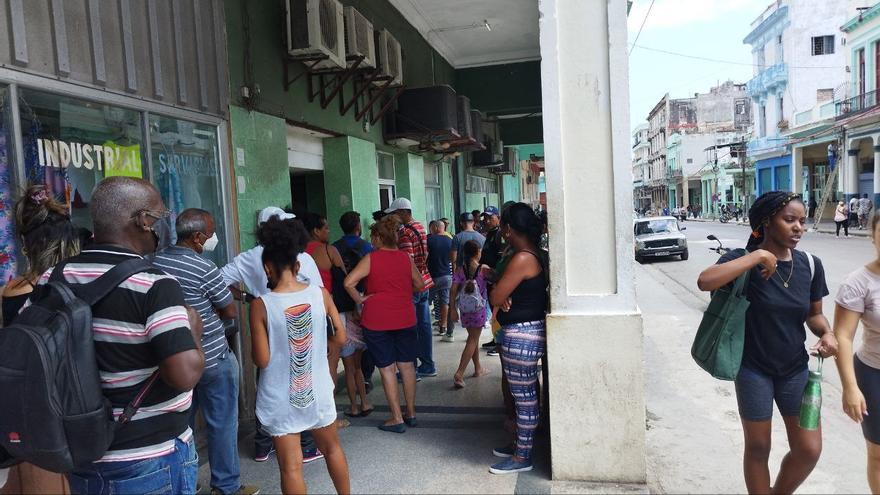
![]() 14ymedio, Juan Diego Rodríguez, Havana, 19 April 2023 — The Central Bank of Cuba (BCC) announced on Wednesday the release of a new 100-peso bill, which comes just as the depreciation of the currency against the dollar and the collapse of the ATM network on the Island worsens. The institution pointed out that this denomination is printed with the date of 2023 and retains the main characteristics of the previous issues.
14ymedio, Juan Diego Rodríguez, Havana, 19 April 2023 — The Central Bank of Cuba (BCC) announced on Wednesday the release of a new 100-peso bill, which comes just as the depreciation of the currency against the dollar and the collapse of the ATM network on the Island worsens. The institution pointed out that this denomination is printed with the date of 2023 and retains the main characteristics of the previous issues.
However, the new bill, which will circulate simultaneously with the previous versions, has no tactile feature and is not in the Braille system for the blind, without the authorities offering an explanation. The banknote maintains the logo of the BCC and the signature of the president of the Central Bank, while the inscription and the year of printing appear in magenta.
The announcement of this new banknote comes at a particularly hard time for Cubans, who have to stand in long lines to withdraw money from the few ATMs that still have cash. “Imagine the level of stress that this causes,” said a resident of Central Havana who had to go to three ATMs to find one that worked.
The man explained to 14ymedio that he sent money to his sister in Párraga, in the municipality of Arroyo Naranjo, to help her pay for an operation for her son. However, when he went to the ATM he couldn’t get cash because it was out of service.
“I gave it to her by transfer because I can’t go there; she lives quite far away,” he said, remembering that driving is not an alternative either because of the shortage of fuel on the Island.
ATMs in Cuba can’t cope. No fewer than 150 of the 521 that Banco Metropolitano (Banmet) has in Havana are out of service, which means that 30% of them are damaged. This was confirmed by Banmet to the official press last Sunday.
To a query by journalist Francisco Rodríguez Cruz, the bank’s management responded that the technicians are repairing the dispensing modules and the keyboards, which are the parts with the most breakdowns, and they are expecting the new parts to arrive next week.
In the article, Banmet said that “the equipment dispenses more than 160 million pesos every day” and that it needs a change “because of technological obsolescence.” However, it doesn’t have “an immediate response.” What has been enabled, it insisted, are “domestic alternatives” to mitigate the crisis.
The bank explains that it has increased electronic payments with “all” the agents who offer services or sell goods. Similarly, customers have the option of using the Caja Extra unit to get cash in the 1,904 enabled ration stores, and at least one branch per municipality has extended hours on weekends.
What the banking authorities do not say is that in many ration stores they claim that they have no connection with Transfermóvil to dispense cash, or that they don’t have any cash because everyone that day has paid electronically. The amounts that can be taken out are also low.
From April 8 to 14, cash withdrawals exceeded 200 million per day, but many ATMs, Banmet acknowledged, are only authorized to carry out electronic operations and to check balances.
The bank’s response generated discontent from social media users, who claim that it is “usual” to hear “regrets” from officials about things that do not work well in Cuba, but few solutions are offered such as the availability of POS payment terminals in businesses.
On Calle Infanta, one of the busiest streets in Central Havana, there are three ATMs, but two of them are broken, and the one that works has problems with the screen that makes it difficult to see the information, a Cuban complained.
In addition to the Cuban capital, the ATM crisis extends to the interior of the country. In Sancti Spíritus this week, the banking authorities said that there is no shortage of cash in the machines. “The ATMs have never stopped paying due to lack of money,” María Efigenia Caballero, director of the Banco Popular de Ahorro (BPA), told Escambray.
The director said that the 11 ATMs in the province operate normally, although many of them are old and overused. A resident of the northern outskirts of the city of Sancti Spíritus told 14ymedio that it’s “simply a lie,” because in reality there are only nine ATMs, and most are located in the center. “For example, I have to travel about four miles to get to an ATM, and it doesn’t always work,” he complained.
Translated by Regina Anavy
____________
COLLABORATE WITH OUR WORK: The 14ymedio team is committed to practicing serious journalism that reflects Cuba’s reality in all its depth. Thank you for joining us on this long journey. We invite you to continue supporting us by becoming a member of 14ymedio now. Together we can continue transforming journalism in Cuba.
